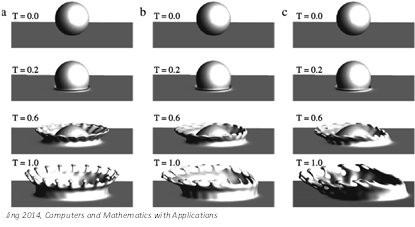Aerosol generation from liquid droplet impact on solid surfaces
- Academic lead
- Dr David Harbottle, School of Chemical and Process Engineering, D.harbottle@leeds.ac.uk
- Industrial lead
- Dr Martyn Barnes, Sellafield Ltd
- Co-supervisor(s)
- Prof Mike Fairweather, School of Chemical and Process Engineering, M.Fairweather@leeds.ac.uk , Dr Mark Wilson, School of Mechanical Engineering, M.Wilson@leeds.ac.uk , Dr Tim Hunter, School of Chemical and Process Engineering, T.N.Hunter@leeds.ac.uk
- Project themes
- Industrial Processes, Underpinning Methods for Fluid Dynamics
Liquid jets are widely encountered from ink jet printing to ‘big industry’ which frequently use high velocity jets to decontaminate surfaces (remove radionuclides or heavy metals embedded in surfaces). For those high velocity jets, instabilities in the liquid jet cause its breakup into sub-millimetre droplets which then impact the surface to remove contaminants via abrasion. The impacting droplets can rebound or breakup into smaller aerosol droplets. The outcome of a droplet impact event depends on several parameters including the surface wettability and roughness, the fluid properties such as viscosity and surface tension, and the droplet impact velocity. In the nuclear industry it is undesirable to have excessive droplet splashing as this results in the generation of micron-sized aerosol droplets which are readily mobile and can easily spread contaminants to the surrounding environment (similar to the aerosol spread of Covid-19). In the project you will determine the critical conditions that promote the formation of aerosol droplets following the impact of high velocity sub-millimetre-sized droplets on model surfaces. Routes to minimize aerosol generation while also maintaining the critical velocity needed for decontamination will be explored and may include modifying the Newtonian, or non-Newtonian response of the fluid, inclusion of additives to modify the surface tension and surface rheology of a liquid droplet, and tuning the surface properties to supress aerosol droplet generation.

